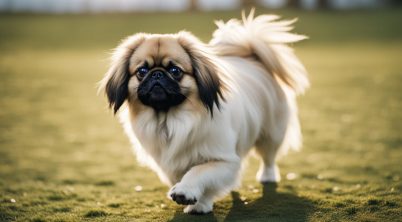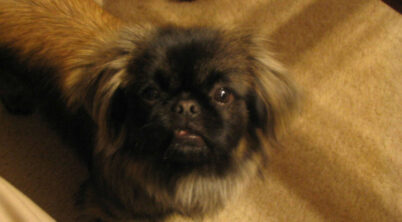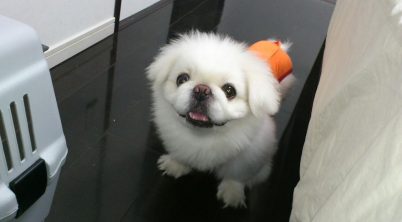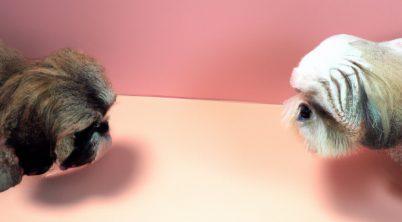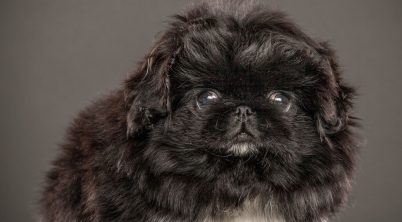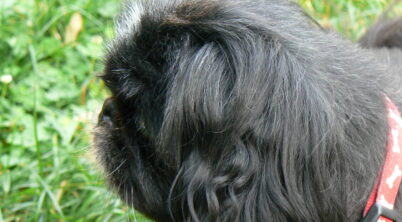Leucistic Pekingese dogs are a unique variation of the Pekingese breed, characterized by their distinctive white coat which sets them apart from the standard coloration of the breed. The term “leucism” refers to the partial loss of pigmentation which results in white, pale, or patchy coloration of the skin, hair, and eyes. Unlike albinism, which is a complete lack of pigmentation, leucistic animals typically have normal coloring in their eyes and other areas.
The leucistic Pekingese has the same charming characteristics and royal demeanor as any Pekingese. Bred for centuries to be the cherished companions of the imperial family of China, these dogs carry themselves with a proud bearing befitting their noble heritage. Their leucistic coat does not alter their spirited and affectionate nature, but it does require certain considerations in care and breeding, as it can be linked with health considerations distinct from the typical Pekingese.
Because of their rarity and distinctive appearance, leucistic Pekingese may attract attention from pet enthusiasts and breeders alike. Though they may feature in breeding programs aiming to produce pets with unique coloration, their well-being and health should always remain a primary concern.aryl
Table of Contents
Leucistic Pekingese Overview
The Leucistic Pekingese is a distinct variant of the Pekingese breed, characterized by a reduction in melanin that leads to a pale coat coloration, while maintaining the usual eye color. This section explores the unique genetics and appearance that differentiate a leucistic Pekingese from other color variations of the breed.
Defining Leucism
Leucism is a genetic condition that results in a partial loss of pigmentation in an animal, which causes white, pale, or patchy coloration of the coat. Unlike albinism, which is a total absence of melanin, leucism is caused by a reduction in all types of skin pigment, not just melanin. Hence, a leucistic Pekingese will have the normal color in their eyes and other soft tissues.
Contrast Between Albino and Leucistic
| Trait | Albino Pekingese | Leucistic Pekingese |
|---|---|---|
| Eye Color | Typically red or very light blue | Normal as per non-leucistic individuals |
| Coat Color | Completely white without any pigmentation | White or pale but may have patches where normal coloration is displayed |
| Genetic Difference | Lack of melanin production | Reduction in all pigment production |
| Sensitivity to Sunlight | High due to absence of protection by pigmentation | Less compared to albinism but still higher than normal pigmentation levels |
The primary difference lies in the melanin production—albinism involves a complete lack of melanin, which affects all pigmented parts of the body, including the eyes and skin. Leucism, on the other hand, is a broader reduction of pigment that allows some normal coloration, particularly noticeable in the eyes of a leucistic Pekingese.
Origin and History
The Pekingese is a toy dog breed with deep historical roots in ancient China. Originating from the lap of Chinese royalty, the breed is emblematic of the imperial courts where it was cultivated for its lion-like appearance, believed to reflect a creature of great power in Chinese mythology.
During the Second Opium War in 1860, British troops invaded the Chinese Imperial Palace at Yuanmingyuan and discovered several of the breed. Five of these dogs were taken and brought back to England, increasing the breed’s prominence in the West. One notable Pekingese, named “Looty,” was presented to Queen Victoria, further cementing its association with nobility outside of China.
Throughout its history, the Pekingese has been closely tied to Chinese royalty. The breed was kept within the Forbidden City, the royal palace located in what is now known as Beijing. Their ownership was once restricted to the Chinese imperial family, symbolizing their high stature and deemed a treasure of the ancient dynasty.
Characteristics of the Pekingese:
- Size: Small, but well-constructed
- Coat: Long and flowing
- Gait: Rolling, imparting a distinctive dignity
- Temperament: Independent, regal in demeanor
The leucistic Pekingese, a variation with a reduced pigmentation resulting in a pale coat color, has inherited the same rich history as its typically colored counterparts. This rare trait does not change the breed’s esteemed lineage, which continues to be celebrated by admirers worldwide.
Physical Characteristics
Leucistic Pekingese are distinct within the breed, recognized by their lighter coloration and the same physical features synonymous with their breed standard.
Color Variations
Leucistic Pekingese display a noticeable difference in their coat color, which is typically a pale shade that may range from white to off-white, lacking the stronger pigmentation found in non-leucistic dogs. While a Pekingese’s coat can come in various colors such as red, tan, black, and sable, leucistic specimens may retain traces of these colors in a muted form. They often exhibit the breed’s characteristically long, coarse, double coat, referred to as a lion’s mane, although the tones are more subdued.
- Typical Coat Colors in Pekingese (for comparison):
- Red
- Tan
- Black
- Sable
- Leucistic Coat Appearance:
- Color: White to off-white
- Texture: Long, coarse, double-coated
Eyes and Vision
The eyes of a leucistic Pekingese maintain the large, expressive quality that the breed is known for, set in a typically short snout that adds to their distinct facial structure. Despite the paler skin and fur, the iris retains its color, often contrasting vividly with the leucistic coat. Vision is generally unaffected by leucism, so their alertness and keen regard for the environment remains consistent with the non-leucistic Pekingese.
- Eye Characteristics:
- Large and expressive
- Iris: retains color despite leucism
- Set in a short snout
Leucistic Pekingese share the same potential for vision health issues as other color variations of their breed, and caregivers should monitor for any signs of eye discomfort or changes in vision.
Health and Genetics
In examining the Pekingese breed, particular attention must be paid to their health and genetic makeup. Many of the health concerns these dogs face are intertwined with their genetic traits, including the presentation of leucism in rare cases.
Common Health Concerns
- Intervertebral Disc Disease: A prevalent issue in Pekingese dogs, intervertebral disc disease affects the cushioning discs between the vertebrae. Symptoms may include pain, reduced mobility, and in severe cases, paralysis.
- Brachycephalic Syndrome: Due to their distinct short-muzzled face, Pekingese are prone to brachycephalic syndrome, which can lead to breathing difficulties and overheating.
- Eye Issues: The prominent eyes of the Pekingese are susceptible to a variety of conditions, such as dry eyes, ulcers, and prolapses.
- Fold Dermatitis: The skin folds characteristic of the breed can trap moisture and debris, leading to irritation and skin infections known as fold dermatitis.
Genetic Conditions and Leucism
- Genetic Health: The Pekingese possess inherited traits that predispose them to specific health concerns. It is crucial to understand their genetic background when considering their overall well-being.
- Leucism: This genetic condition results in parts or all of the Pekingese’s coat appearing lighter due to reduced pigment. Unlike albinism, leucism does not affect the coloration of the skin or eyes. While it does not directly impact health, leucism is indicative of the diverse genetic factors that can manifest within the breed.
Temperament and Behavior
The Leucistic Pekingese is known for its distinct personality that is a composite of loyalty and independence, marked by an alert temperament. These dogs are often affectionate with those they trust, demonstrating a social side within their family circle.
Personality Traits
A Leucistic Pekingese carries a strong personality that reflects a notable blend of stubbornness and loyalty. They possess an independent streak which can sometimes be interpreted as aloofness, but they remain deeply loyal to their owners. These dogs are typically alert, often serving as good watchdogs. They enjoy a relatively moderate energy level, avoiding overly strenuous activities due to their stature and potential for breathing challenges related to their brachycephalic facial structure.
- Social: Typically friendly, thriving on attention from their owners.
- Affectionate: Often form strong bonds, displaying affection freely.
- Stubborn: Training can be challenging and requires patience.
Interactions with Other Pets and Kids
The Leucistic Pekingese may exhibit variability in its interactions with other animals and children. When socialized properly from a young age, they can be friendly towards other pets, including dogs and cats. However, their independence and sometimes possessive nature mean interactions should be supervised, especially with smaller pets which they may try to dominate.
With kids, Leucistic Pekingese can be affectionate, but their tolerance for rough play is low. Families should teach children how to interact with these dogs properly to foster a positive relationship. It is crucial to note that they are best suited for homes with older children who can understand and respect their boundaries.
- Dogs: Can live in harmony when socialized but may show dominance.
- Cats: Potential for peaceful coexistence with proper introductions.
- Kids: Prefer gentle handling; best with older, respectful children.
Care and Grooming
Grooming a leucistic Pekingese, with its distinctive white coat, requires regular and diligent care to maintain their health and appearance. Their coats are prone to matting and require frequent brushing.
Weekly Brushing: At least 2-3 times a week, the leucistic Pekingese should be brushed thoroughly to prevent tangles and matting. Use a soft bristle brush or a pin brush.
Bathing: A monthly bath is recommended to keep their white coat clean. Use a gentle shampoo formulated for dogs to avoid skin irritation.
Special Considerations:
- Eyes: The breed often has weepy eyes, so daily cleaning with a soft, damp cloth is necessary.
- Skin Folds: Regular checks and cleans of their facial wrinkles can prevent infections.
Evironmental Needs: The Pekingese does not tolerate heat well, so a cool, indoor environment is optimal. Access to shade and fresh water when outside is crucial.
Socialization: This breed benefits from early socialization to become well-adjusted. Exposure to different people and settings is advised to help them develop a calm demeanor.
Nails and Dental Care:
- Nails: Trim their nails regularly to prevent overgrowth and splitting.
- Teeth: Brush their teeth several times a week to prevent dental diseases.
The Pekingese enjoys interactive toys that can keep them engaged and active indoors, contributing to their mental health and social needs. Owners should ensure that playtime is part of their daily routine.
Adoption and Purchasing
When seeking a leucistic Pekingese, one must navigate the nuances between adoption and purchasing. This includes understanding the availability, costs, and considerations specific to this rare color variation of the breed.
Finding a Leucistic Pekingese
The search for a leucistic Pekingese can be challenging due to their rarity. Potential owners can approach specific rescue organizations dedicated to Pekingese breeds, which sometimes have leucistic Pekingese looking for homes. Adoption fees typically cover the expenses of care prior to adoption and are usually around $300. Alternatively, purchasing from a breeder allows potential owners to find purebred Pekingese puppies, including the even rarer pink leucistic Pekingese. Breeders may offer top quality, health-tested Pekingese pups, with prices ranging significantly from $800 to $3,000.
- Adoption Options:
- Rescue organizations and networks
- Shelter adoption events
- Breed-specific rescues
- Purchasing Options:
- Registered breeders specializing in leucistic Pekingese
- Professional breeding establishments with health-tested lineage
- Online listings for Pekingese puppies for sale
Considerations Before Adoption
Before adopting a leucistic Pekingese, it is crucial to assess the associated responsibilities and costs. Individuals should consider the following:
- Health: Ensure the Pekingese is health-tested, as some leucistic animals may have associated health concerns.
- Temperament: Understanding the breed’s temperament, including its bold and affectionate nature, is essential for a good match.
- Care Costs: Be prepared for ongoing costs, including grooming for their long coats, veterinary care, and any special dietary needs.
Adoption provides an opportunity to offer a home to a Pekingese in need, potentially at a lower pet price than purchasing a puppy. Adopters contribute to animal welfare and may find a rewarding bond with their new pet. However, those seeking a puppy with known lineage or specific health tests may opt to purchase from a reputable breeder.

